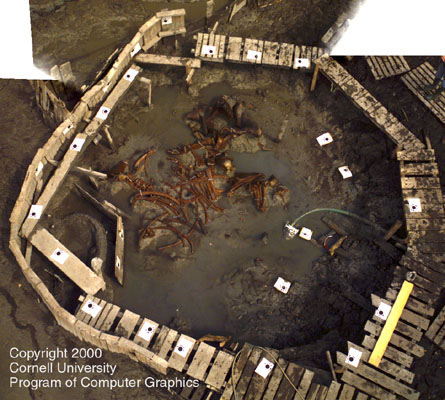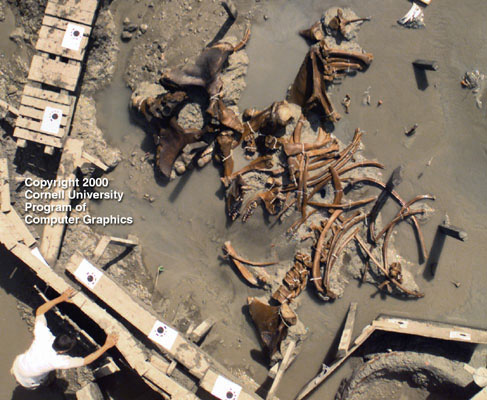Aerial Views
Since the bones were to be removed from the pit that Saturday and
Sunday, a cherry picker was present to aid in documenting their
positions before removal. Here are a couple of views from the overhead
bucket of the cherry picker.

This overview of the pit shows the catwalk and dams. The skeleton
itself is mainly in the upper left quadrant of the image, with one
tusk behind a dam below and to the left of the main skeleton. You can
get some idea of the wet conditions; the green hose at the right
center is perhaps 3 inches in diameter and is constantly pumping water
out of the pit. Click on the image for a high-resolution version
(973x875, about 1.2MB).

Finally, a detailed view of the skeleton itself. This find is
interesting because of the completeness (at least 90% at last report),
preservation state, and articulation of the skeleton. Articulation
means that many of the bones are still in their original positions
relative to each other.
At the top left, the pelvis is visible. At the bottom center of the
image, several vertebrae are still articulated, as are several just to
the right of top center. An array of ribs is visible between these two
groups. At almost the exact center of the image, the lower jaw is
visible, with most teeth intact. The skull, which was in good
condition, has already been removed from the pit. To the right of the
jaw, among the ribs, a hole in the mud is visible; this is actually a
spring, spewing water into the pit continously. Click on the image for
a high-resolution version (1258x1032, about 1.4MB).
At the lower right is an intact tusk behind a plywood dam and
under a protective coating of mud. A major challenge is to allow this
tusk to dry without having it shatter into fragments. In fact, the
whole skeleton was periodically re-wetted with a garden hose to keep
it from drying in an uncontrolled fashion.
Back to main Mastodon Dig page
Stephen H. Westin <westin@graphics.cornell.edu>
Last modified: Mon Oct 23 11:41:33 Eastern Daylight Time 2000

